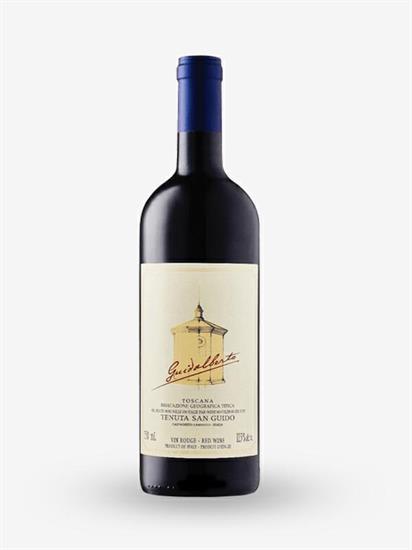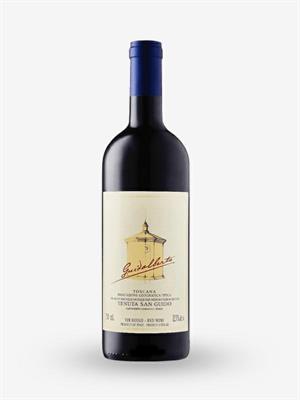TOSCANA ROSSO IGT 2019 GUIDALBERTO TENUTA SAN GUIDO0,750
TOSCANA ROSSO IGT 2019 GUIDALBERTO TENUTA SAN GUIDO0,750
€ 68,00
TENUTASANGUIDO132
8881248151783
Tuscany
NR
2022
TENUTA SAN GUIDO
60% Cabernet Sauvignon, 40% Merlot
PRODUCT INFORMATION
Denomination: Tuscany Typical Geographical Indication
First vintage: 2000
Grapes: 60% Cabernet Sauvignon 40% Merlot
Analytical data: Alcohol content: 14.00%, PH: 3.48, Total acidity: 5.95, Zuch.res.: 0.13 g/l
Type of land: The land on which the vineyards stand have various and composite morphological characteristics
with a strong presence of calcareous areas rich in marl and stones and partially clayey; they are located at an altitude
between 100 and 300 meters above sea level, with South/South-West exposure.
Training system: Spurred cordon
Planting density: 6,250 vine stocks per hectare
Climatic trend and characteristics of the vintage: A very hot vintage that will perhaps be remembered as one
of the driest since 2003. Although autumn began with rainfall and temperatures above normal
seasonal, December and January were instead very cold months with freezing daytime and nighttime temperatures
even below zero, accentuated by the strong north winds and lack of rainfall. The cold tested positive
helping to naturally eliminate insects and fungal diseases of the vine. Winter, however, was also
characterized by little rainfall, not enough to supply the underground water resources. From March
temperatures started to rise and with the first week of April the beautiful sunny days gave
off to spring. Even the spring, with the exception of some sporadic rain showers, was protected by
a particularly dry climate. Summer arrived already in mid-May with temperatures rising frequently
above the seasonal average. The following summer months were extended by days of sunshine and temperatures above
above the seasonal average. Fortunately, the daytime sea breezes, alternating with the nocturnal land breezes,
they brought refreshment to the vines, avoiding the onset of suffering from water/thermal stress. Further luck,
in a particularly hot year, it was granted by the particularity of the territorial microclimate of Bolgheri e
Bolgheri Sassicaia, where thanks to its conformation, altitude, exposure and location close to the
sea and equally surrounded by Mediterranean scrub woods, it was much less affected by the scorching heat
compared to other territories. The veraison began in mid-July and the climatic trend anticipated the timing
ripening of the grapes. On August 15th, however, a disturbance of Atlantic origin brought rain and a
sudden climate change, conditioned by cooler air. This is allowed, albeit in a sale
started early (at the end of August for the Merlot grapes), to be able to continue more calmly for the grapes
Cabernet Sauvignon until the end of September and allowing, thanks to the cooler temperatures, to express
the aromatic component is good during phenolic maturation. The climatic trend has affected the yields of
production, on average 20% less than a normal year, but this did not compromise
obtaining a high quality product. Healthy, crunchy and well-ripe grapes made it possible to obtain it
of musts that are not excessively structured, compared to what the vintage could have done, independent of a good one
acidity supporting a higher alcohol content than other vintages. The softness and sinuosity of the tannins
which was already clearly identifiable in the musts, are the basic characteristic of this Guidalberto 2017. A wine
which may require a longer maturation time in glass but which will certainly be capable of doing so
developing a bouquet and fullness in the mouth, perhaps superior to that of wines from years considered better.
2
Harvest period: The harvest, strictly by hand, began with the Merlots at the end of August and continued
then from September with Cabernet Sauvignon.
Winemaking notes: Sorting and careful selection of bunches and berries by hand, using a sorting table. Office
pressing and destemming of the bunches to avoid breaking the grapes and excessive release of tannins.
Alcoholic fermentation in stainless steel vats at a controlled temperature maintained around 26-28°C, without any
addition of external yeasts. The macerations of this vintage lasted approximately 12-15 days for the Merlot and
10-13 days for Cabernet Sauvignon grapes, so as to limit the excessive release of tannic in a vintage certainly
not low in anthocyanins. Frequent reassemblies and délestages allowed for greater expression
aroma of the musts. The malolactic fermentation, which began in early November, was also complete
carried out in steel vats, at the end of which the musts were placed in barriques for refinement.
Aging: Upon completion of the malolactic fermentation the wine was placed in oak barriques
French, and a small part of American woods, for a period of 15 months.
First vintage: 2000
Grapes: 60% Cabernet Sauvignon 40% Merlot
Analytical data: Alcohol content: 14.00%, PH: 3.48, Total acidity: 5.95, Zuch.res.: 0.13 g/l
Type of land: The land on which the vineyards stand have various and composite morphological characteristics
with a strong presence of calcareous areas rich in marl and stones and partially clayey; they are located at an altitude
between 100 and 300 meters above sea level, with South/South-West exposure.
Training system: Spurred cordon
Planting density: 6,250 vine stocks per hectare
Climatic trend and characteristics of the vintage: A very hot vintage that will perhaps be remembered as one
of the driest since 2003. Although autumn began with rainfall and temperatures above normal
seasonal, December and January were instead very cold months with freezing daytime and nighttime temperatures
even below zero, accentuated by the strong north winds and lack of rainfall. The cold tested positive
helping to naturally eliminate insects and fungal diseases of the vine. Winter, however, was also
characterized by little rainfall, not enough to supply the underground water resources. From March
temperatures started to rise and with the first week of April the beautiful sunny days gave
off to spring. Even the spring, with the exception of some sporadic rain showers, was protected by
a particularly dry climate. Summer arrived already in mid-May with temperatures rising frequently
above the seasonal average. The following summer months were extended by days of sunshine and temperatures above
above the seasonal average. Fortunately, the daytime sea breezes, alternating with the nocturnal land breezes,
they brought refreshment to the vines, avoiding the onset of suffering from water/thermal stress. Further luck,
in a particularly hot year, it was granted by the particularity of the territorial microclimate of Bolgheri e
Bolgheri Sassicaia, where thanks to its conformation, altitude, exposure and location close to the
sea and equally surrounded by Mediterranean scrub woods, it was much less affected by the scorching heat
compared to other territories. The veraison began in mid-July and the climatic trend anticipated the timing
ripening of the grapes. On August 15th, however, a disturbance of Atlantic origin brought rain and a
sudden climate change, conditioned by cooler air. This is allowed, albeit in a sale
started early (at the end of August for the Merlot grapes), to be able to continue more calmly for the grapes
Cabernet Sauvignon until the end of September and allowing, thanks to the cooler temperatures, to express
the aromatic component is good during phenolic maturation. The climatic trend has affected the yields of
production, on average 20% less than a normal year, but this did not compromise
obtaining a high quality product. Healthy, crunchy and well-ripe grapes made it possible to obtain it
of musts that are not excessively structured, compared to what the vintage could have done, independent of a good one
acidity supporting a higher alcohol content than other vintages. The softness and sinuosity of the tannins
which was already clearly identifiable in the musts, are the basic characteristic of this Guidalberto 2017. A wine
which may require a longer maturation time in glass but which will certainly be capable of doing so
developing a bouquet and fullness in the mouth, perhaps superior to that of wines from years considered better.
2
Harvest period: The harvest, strictly by hand, began with the Merlots at the end of August and continued
then from September with Cabernet Sauvignon.
Winemaking notes: Sorting and careful selection of bunches and berries by hand, using a sorting table. Office
pressing and destemming of the bunches to avoid breaking the grapes and excessive release of tannins.
Alcoholic fermentation in stainless steel vats at a controlled temperature maintained around 26-28°C, without any
addition of external yeasts. The macerations of this vintage lasted approximately 12-15 days for the Merlot and
10-13 days for Cabernet Sauvignon grapes, so as to limit the excessive release of tannic in a vintage certainly
not low in anthocyanins. Frequent reassemblies and délestages allowed for greater expression
aroma of the musts. The malolactic fermentation, which began in early November, was also complete
carried out in steel vats, at the end of which the musts were placed in barriques for refinement.
Aging: Upon completion of the malolactic fermentation the wine was placed in oak barriques
French, and a small part of American woods, for a period of 15 months.
REVIEW THE PRODUCT
Login to read the reviews and write your own -- Proceed to LOGIN
RECENTLY VIEWED
Powered & Designed by Passepartout








